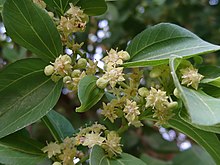Ziziphus
| Ziziphus | |
|---|---|

| |
Ziziphus jujuba, by Adolphus Ypey
| |
| Scientific classification | |
| Kingdom: | Plantae |
| Clade: | Tracheophytes |
| Clade: | Angiosperms |
| Clade: | Eudicots |
| Clade: | Rosids |
| Order: | Rosales |
| Family: | Rhamnaceae |
| Tribe: | Paliureae |
| Genus: | Ziziphus Mill. (1754) |
| Type species | |
| Ziziphus jujuba Mill. (1768), nom. cons.[2]
| |
| Species[1] | |
|
68; see text | |
| Synonyms[1] | |
| |
Ziziphus
Well known species include the commonly cultivated Ziziphus jujuba (
.Etymology
The generic name is derived via classical
Ecology
Ziziphus species are used as food plants by the larvae of some Lepidoptera species including Bucculatrix zizyphella, which feeds exclusively on the genus, and Endoclita malabaricus.
Species are distributed throughout the world in tropical and warm temperate areas, from rain forests to deserts. Some species are evergreen, others are winter or drought deciduous.
Species adapted to dry climates are smaller and have oleifera cells that produce a fragrant aroma.
Uses
The temperate Ziziphus jujuba (Chinese jujube) and the tropical Ziziphus mauritiana (Indian Jujube) are economically important fruit trees.
In
Mythology
The mythological lotus tree which occurs in Homer's Odyssey is often equated with Z. lotus.[5]
The
Species
68 species are accepted.[1]
- Ziziphus abyssinica Hochst. ex A.Rich. – dry zones of tropical Africa
- Ziziphus affinis Hemsl.
- Ziziphus andamanica Bhandari & Bhansali
- Ziziphus angustifolia (Miq.) Hatus. ex Steenis
- Ziziphus apetala Hook.f. ex M.A.Lawson
- Ziziphus attopensis Pierre
- Ziziphus borneensis Merr.
- Ziziphus brunoniana C.B.Clarke ex A.W.Hill
- Ziziphus budhensis Bhattarai & Pathak – Central Nepal
- Ziziphus calophylla Wall.
- Ziziphus cambodiana Pierre – Cambodia, Laos, Vietnam
- Ziziphus colombiana Suess. & Overkott
- Ziziphus cotinifolia Reissek
- Ziziphus crebrivenosa C.B.Rob.
- Ziziphus cumingiana Merr.
- Ziziphus djamuensis Lauterb.
- Ziziphus elegans Wall.
- Ziziphus fungii Merr.
- Ziziphus funiculosa Buch.-Ham. ex M.A.Lawson
- Ziziphus glabrata (B.Heyne ex Schult.) B.Heyne ex Wight & Arn.
- Ziziphus globularis Wall.
- Ziziphus guaranitica Malme
- Ziziphus hajarensis Duling, Ghaz. & Prend.
- Ziziphus hamur Engl.
- Ziziphus havilandii Ridl.
- Ziziphus hoaensis Pierre
- Ziziphus horrida Roth
- Ziziphus horsfieldii Miq.
- Ziziphus hutchinsonii Merr. – Philippines
- Ziziphus incurva Roxb.
- Ziziphus javanensis Blume
- Ziziphus jujubaMill. – Jujube
- Ziziphus kunstleri King
- Ziziphus laui Merr.
- Ziziphus leucodermis (Baker) O.Schwartz
- Ziziphus linnaei M.A.Lawson
- Ziziphus lotus (L.) Lam. – Mediterranean region
- Ziziphus mairei Dode
- Ziziphus mauritiana Lam. – widespread through Old World tropics and subtropics
- Ziziphus melastomoides Pittier
- Ziziphus montana W.W.Smith
- Ziziphus mucronata Willd. buffalo thorn – southern Africa
- Ziziphus nummularia (Burm.f.) Wight & Arn. – Thar Desert of India and Pakistan
- Ziziphus oenopolia (L.) Mill.
- Ziziphus otanesii Merr.
- Ziziphus oxyphylla Edgew.
- Ziziphus papuana Lauterb.
- Ziziphus pernettyoides Ridl.
- Ziziphus poilanei Tardieu
- Ziziphus pubescens Oliv.
- Ziziphus pubinervis Rehder
- Ziziphus quadrilocularis F.Muell. – northern Australia
- Ziziphus ridleyana Rasingam & Karthig.
- Ziziphus rivularis Codd
- Ziziphus robertsoniana Beentje
- Ziziphus rubiginosa D.G.Long & Rae
- Ziziphus rugosa Lam.
- Ziziphus spina-christi (L.) Desf.
- Ziziphus subquinquenervia Miq.
- Ziziphus suluensis Merr.
- Merr. – Philippines
- Ziziphus timoriensis DC.
- Ziziphus trinervis (Cav.) Poir.
- Ziziphus truncata Blatt. & Hallb.
- Ziziphus williamii Bhandari & Bhansali
- Ziziphus xiangchengensis Y.L.Chen & P.K.Chou
- Ziziphus xylopyrus (Retz.) Willd.
- Ziziphus zeyheriana Sond.
Other list sources:[7][8][9][10][11][12][13]
Formerly placed here
- Condaliopsis obtusifolia (Hook. ex Torr. & A.Gray) Suess. – Lotebush (as Ziziphus obtusifolia (Hook. ex Torr. & A.Gray) A.Gray)
- Ziziphus celataJudd & Hall)
- Pseudoziziphus parryi (Torr.) Hauenschild – Parry's Jujube (as Ziziphus parryi Torr.)
- Ziziphus mistolGriseb.)
Fossil species
- † Ziziphus hyperboreus Heer (Greenland, Eocene fossil)
- † Ziziphus wyomingianis Berry (Tipperary, Wind River Basin Wyoming, USA, Eocene fossil)[14]
- † = Extinct
Gallery
-
Ziziphus jujuba foliage
-
Dried fruits (azufaifas) in southern Spain of Ziziphus jujuba
-
Azufaifas from Almería
-
Rangareddy district, Andhra Pradesh, India.
-
Ziziphus oenoplia in Shamirpet, Rangareddy district, Andhra Pradesh, India.
-
Hyderabad, India.
-
Ziziphus xylopyrus in Hyderabad, India.
-
Ziziphus xylopyrus in Hyderabad, India.
-
Persian Zizyphus in Iran
References
- ^ a b c d "Ziziphus Mill". Plants of the World Online. Retrieved 18 March 2024.
- ^ "Ziziphus Mill". TROPICOS. Missouri Botanical Database. Retrieved 31 January 2013.
- ^ Sunset Western Garden Book, 1995:606–607
- ISBN 978-0-8493-2678-3.
- ^ https://trees.stanford.edu/ENCYC/ZIZju.htm
- ^ https://faculty.ucmerced.edu/slambden/baha%27i%20encyclopedia/SIDRAH-SIDRAT-BE.htm
- ^ "Query Results for Genus Ziziphus". IPNI. Retrieved August 7, 2009.
- ^ "GRIN Species Records of Ziziphus". GRIN. USDA. Archived from the original on 2000-10-31. Retrieved 2010-10-16.
- ^ "Classificação segundo a Flora brasiliensis" (in Portuguese). Flora brasiliensis. Retrieved August 7, 2009.
- Flora of China. EFloras. Retrieved September 7, 2009.
- ^ The Biodiversity Committee of the Chinese Academy of Sciences (eds.) (2008). "Genus Ziziphus". Beijing, China: Catalogue of Life China: 2008 Annual Checklist China. Retrieved September 9, 2009.
{{cite web}}:|author=has generic name (help) [dead link] - ^ "Flora Europaea: Ziziphus query results". Royal Botanic Garden Edinburgh. Retrieved September 7, 2009.
- ^ "Ziziphus". Integrated Taxonomic Information System. Retrieved 2010-03-08.
- ^ Geological Survey professional paper, Issue 165: Shorter Contributions to General Geology. US Govt. Printing Office. 1930. p. 73. Retrieved May 28, 2011.














